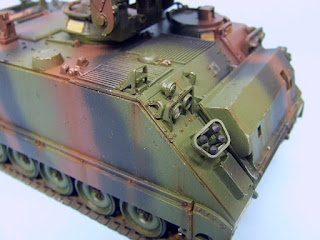This is the first Typhoon I have ever done (though there was
a Matchbox 1:72 Tempest II back in the 80s). Tooled in 2013, this kit looks
very nice in the box, and as a Series 2 kit comes on four sprues and with two
decal options. I had intended to do the more colourful scheme with invasion
stripes, but didn’t trust such large decals not to pose grab and alignment
problems that might result in tearing; plus I wanted to get this one off the
bench before New Year and wasn’t in the market for surprises, or for backing up
and painting the stripes.
Another good-looking addition to Airfix’s stable of British
aviation in miniature, the model’s pleasing lines conceal a few challenges. I
got the feeling Airfix somewhat over-thought the engineering in this kit,
especially in the way the cockpit interior locates, and the cockpit
floor/wheelwells part, which demands a certain order of assembly and
unavoidably introduces the potential for misalignment. Fit problems I found
inevitable, steps at the wingroot being the most serious, though gaps manifested
on the horizontal tails too: whiteglue to the rescue. I expected the keyed
landing gear to be out of alignment also, but surprisingly it was not – the
wheels are flattened and bulged, and keyed to the struts, and once the model is
“up on its feet” the flat spots are firmly to the ground. Assembly took a
little time, and there was plenty of prepainting to do, between the prominent
radiator/carburettor intake assembly, the cockpit and surrounds, landing gear,
bay doors and propeller assembly.
Overall, though, the model looks the part, and once it was
together the finishing techniques flowed along well enough. I used Tamiya’s
accurised RAF late-WWII shades (XF-81, -82 and -83) topped with Microscale
clears and Florey panel wash, finished with oil wash weathering and Mig
pigments. I used the Eduard mask set for the canopy and wheels, and the AML
masks for the Type A camo scheme. The set includes an extra sheet of straight
strips doubtless intended for painting the invasion stripes.
The best part of the kit was the decals, they were superb
and pulled into surface detail even before MicroSet was applied. Very thin,
they grabbed a bit quickly, but are of solid tone, fully in-register, and seem
especially accurate. They behaved much better than the sheet in the Spitfire I
finished last, indeed I completed all decals, with the exception of the leading
edge yellow stripes, in a single day of work.
Criticisms? The small antenna on the underside of the
fuselage did not fit its locator hole – I fiddled and fumbled with it for a
good twenty minutes, most of which was involved in getting hold of the tiny component,
over and over and over, while applying a file to the base until it actually
dropped into the receiver. The tailwheel is moulded as one part and must be
seated before the fuselage is closed, which ups the odds of damage during
handling and makes painting the unit a matter of a small brush and prayer. When
the propeller is finally installed, the mounting calls for a cylindrical unit
to be inserted between four moulded guides which “tension” it into place – why
so complicated? The fuselage aperture had to be filed to accommodate the outer
ring of the cylinder, and when it slid home it became apparent the outer
diameter of the fuselage mouldings is larger than the outside diameter of the
spinner backplate, leaving a strip of unpainted plastic exposed – yet with the
prop now quite firmly in place there seems no way to tease it free again to
paint the strip. Chancing getting camo green on the satin black spinner is not
a risk I’m willing to take at the very finish, so it stands as-is, and angle of
view will hopefully conceal the flaw for the moist part.
I have another of these, in the “Dogfight Doubles” edition
with Pips Priller’s FW 190 (an unusual combination, as the Tiffie found its
forté as a ground attack plane and probably never tangled with a 190, at least
not on purpose) but it may be a few years before I welcome going 15 rounds with
this kit again. There are some lessons learned here, of course, such as leaving
the main gear bay doors off until after the struts are in place, which would
make it easier to keep the doors aligned and not “toed-in” a bit.
Enjoyable? It’s always nice to see a project come together,
but I would have to say I was happy to see this one leave the bench in the end.
Maybe the shake’n’bake kits have somewhat spoiled me, but I had hoped for
better alignment. Recommended nevertheless, to those with a little experience
under their belts.























































